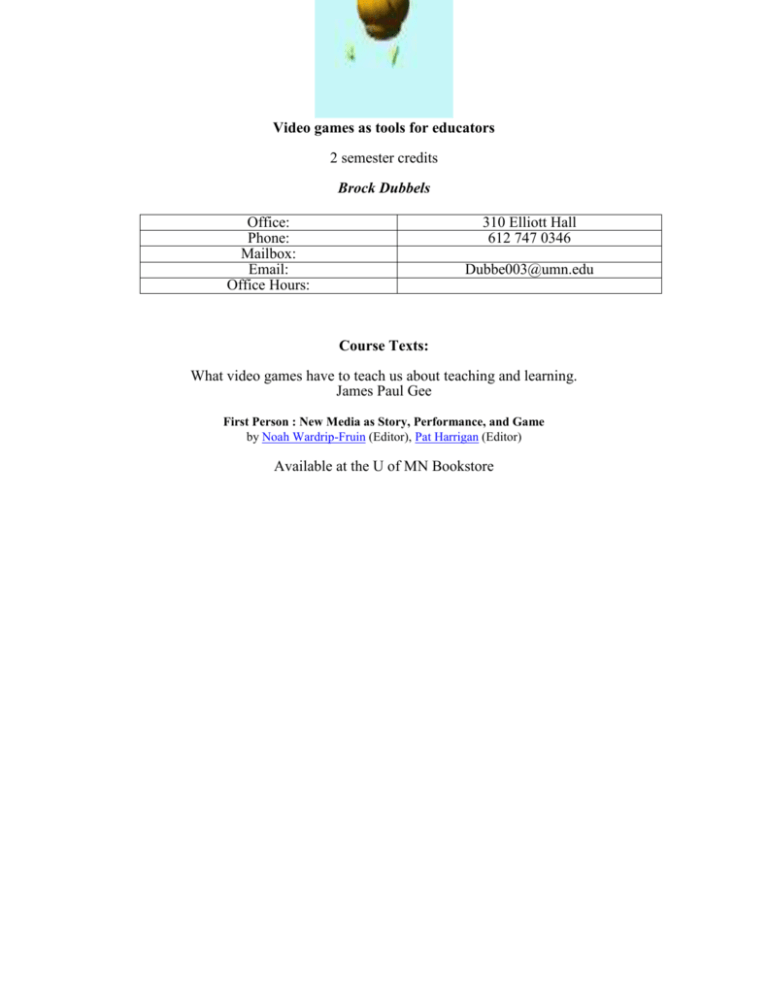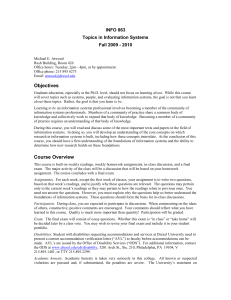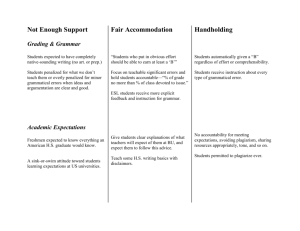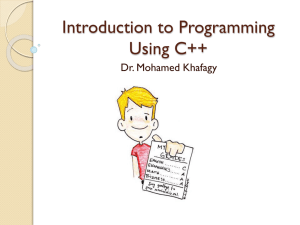Syllabus Checklist - Trinity University
advertisement

Video games as tools for educators 2 semester credits Brock Dubbels Office: Phone: Mailbox: Email: Office Hours: 310 Elliott Hall 612 747 0346 Dubbe003@umn.edu Course Texts: What video games have to teach us about teaching and learning. James Paul Gee First Person : New Media as Story, Performance, and Game by Noah Wardrip-Fruin (Editor), Pat Harrigan (Editor) Available at the U of MN Bookstore Major Content and Outcomes of EngC 1014-01 Yes, this is a class about video games! There are some important things to be learned through games. One the most important is the idea of play, and how it is that we can make a thing challenging and fun. What other reason might there be to engage in an activity for hours upon hours? We will be looking at games from several perspectives, the most important being pedagogy and potential applications of games and their foundations in teaching and learning. There are several things that will be explored in the course of this class. We will look at activity theory and some of the ideas that led up to it. We will consider ideas in curriculum design and accountability as espoused by the “spiral curriculum” which has been considered by many schools in the field of learning, as well as issues like problem solving, expertise, meaning making (semiotics), identity, artistry and aesthetics, motivation and engagement, as well as the ways that video games are built on the same ideas that great literature, drama, and film are: the narrative. Learning objectives: 1. What is a game? 2. Who is playing games? 3. How can we understand Play and use it in the classroom? 4. How do games scaffold a leaner with purpose and engage them? 5. How does one challenge a learner, but not frustrate them? 6. What is the pedagogy of game design? 7. How do games create accountability? 8. Do games shape of cultural attitudes? 9. Games as a new narrative. 10. The role of learning objects. 11. Aesthetics and analysis of games as a medium. 12. How can we bring this to the classroom? Class 1. Introduction to games Objectives: What is a game? A look at who is playing games. Games ~ A look at the research ~ from: Rideout, V.J., Vandewater, E.A., & Wartella, E.A. (2003) Zero to Six: Electronic Media in the Lives of Infants, Toddlers and Preschoolers. World Wide Web: http://www.kff.org/entmedia/loader.cfm?url=/commonspot/security/getfile .cfm&PageID=22754. last accessed: 9/10/04. Jones, S. (2003) Let the games begin: Gaming technology and entertainment among college students. World Wide Web. http://www.pewinternet.org/PPF/r/93/report_display.asp Last accessed 9/10/04 ISDA (2003) Essential Facts on Video Game Players 2003 Sales Demographics and Use Data. World Wide Web: http://www.idsa.com/pressroom.html last accessed 10/10/04 In class journaling/Interview: what are and were your favorite games? Play games Discuss Assignments, Choose topics, Play Games, Start Journal Readings due for Class 2: Chapter 1 Wardip-Fruin, N. and Harrigan, P. (2004). First Person : New Media as Story, Performance, and Game. MIT Press. Cambridge, MA Gee, J. P. (2003) What video games have to teach us about learning and literacy. Palgrave/Macmillan: New York, NY Class 2. Playing the curriculum Objective: How can we understand Play and use it in the classroom? Games as a new narrative. Interview classmate’s reading journal, give a gist presentation, and play games. Readings for Class 3: Chapter 2 from: Gee, J. P. (2003) What video games have to teach us about learning and literacy. Palgrave/Macmillan: New York, NY Chapter 5 from Wardip-Fruin, N. and Harrigan, P. (2004). First Person : New Media as Story, Performance, and Game. MIT Press. Cambridge, MA Class 3. What do games do well? Issues of engagement, Empowered learning, co-design, customization, manipulation, identity, motivation and engagement, problem solving, well-ordered problems, pleasantly frustrating, cycles of expertise, information on demand, fish tanks, sandboxes, and complex systems Interview classmate’s reading journal, give a gist presentation, discuss first paper, and play games Readings for Class 4: Chapter 3, 4, 5, 6 (on webct) from: Crawford, C. (2003) On Game Design. New Riders. Indianapolis, IN Class 4. What’s in a game? How are they conceptualized by designers? Objectives: How do games scaffold a leaner with purpose and engage them? Interview classmate’s reading journal; give a gist presentation; Play Games Readings for Class 5: Chapter 2, 3, & 4 Wardip-Fruin, N. and Harrigan, P. (2004). First Person : New Media as Story, Performance, and Game. MIT Press. Cambridge, MA Class 5. Objectives: How do games scaffold a leaner with purpose and engage them? How does one challenge a learner, but not frustrate them? Review journals and game play; Create framework for Paper 2 Readings for Class 6 WebCT Frasca, G (2003) LUDOLOGY MEETS NARRATOLOGY: Similitude and differences between (video)games and narrative. Costikyan, G. (1994) I Have No Words & I Must Design. World Wide Web. http://www.costik.com/nowords.html Last visited, 12/23/03 Holland, W., Jenkins, H., & Squire, S. (In Press). Theory by Design Class 6. Games in education Objectives: What is the pedagogy of game design? How do games create accountability? Paper 2 Due Review journals and game play Readings for Class 7: On WebCT Bartle, R. (2000) Hearts, clubs, diamonds, spades: players who suit muds Consalvo, M. (2003) Game analysis: Developing a methodological toolkit for the qualitative study of games Aarseth, E. (2003) Playing Research: Methodological approaches to game analysis Class 7. Analysis of Games and Players ~ Objectives: Games as a new narrative. The role of learning objects Aesthetics and analysis of games as a medium Review journals, give gist presentation, and game play Reading for class 8: Chapter 3, 4, & 5 from: Gee, J. P. (2003) What video games have to teach us about learning and literacy. Palgrave/Macmillan: New York, NY Class 8. Gender, meaning and identity Objectives: Games as a new narrative The role of learning objects Review journals and game play Readings for Class 9 Chapter 6,7, & 8 from: Gee, J. P. (2003) What video games have to teach us about learning and literacy. Palgrave/Macmillan: New York, NY Class 9. Culture, society, and games Objectives: Do games shape of cultural attitudes; and do games encourage players to adopt alternative cultural roles or identities in game worlds; the relationships between game worlds and lived worlds; the influence of gaming on participants' sense of self and agency. Review journals and game play Class 10. Student Presentations Party Objectives: How can we bring the fundaments and knowledge related to video games to the classroom? Present student papers. Assignments: 1. Game Journal 80 points 2. Group Lesson Plan Based Upon Elements of Game Play – paper 100 pts 3. Self-Ethnography/ Review and Analysis of Game Play – paper & presentation 120 pts 4. Group grading rubric – 30 pts. Submission of all papers: Remember, when you turn in the essay, please include in a folder your finished essay, peer reviewed drafts, paper proposal and the supporting articles you are writing about, along with group collaboration rubrics ~ in that order. Game Journal –article summary 10 points per day = 100 points Combination of reflection from playing the games (5 points) Unifying the ideas from the readings (5 points). Paper 2 How classroom content might be turned into a video game 4 pages Elements of game play and how they relate to classroom learning and curriculum. Paper 3 Analysis of Game Play – Self-Ethnography 6 pages This is to be an analysis of issues that effect game play. Scoring Rubric for Assignments Score of 5: addresses the topic clearly and responds effectively to all aspects of the task explores the issues thoughtfully and in depth is coherently organized, with ideas supported by apt reasons and well-chosen examples has an effective, fluent style marked by syntactic variety and a clear command of language is generally free from errors in mechanics, usage, and sentence structure Score of 4: shows some depth and complexity of thought is well organized and developed with appropriate reasons and examples displays some syntactic variety and facility in the use of language may have a few errors in mechanics, usage, and sentence structure Score of 3: addresses the topic, but may slight some aspects of the task may treat the topic simplistically or repetitively is adequately organized and developed, generally supporting ideas with reasons and examples demonstrates adequate facility with syntax and language may have some errors, but generally demonstrates control of mechanics, usage, and sentence structure Score of 2: distorts or neglects aspects of the task lacks focus, or demonstrates confused or simplistic thinking is poorly organized or developed does not provide adequate or appropriate details to support generalizations, or provides details without generalizations has problems with or avoids syntactic variety has an accumulation of errors in mechanics, usage, and sentence structure Score of 1: lacks focus and coherence or often fails to communicate ideas and suggests an inability to comprehend the question or to respond meaningfully to the topic has very weak organization or little development is unfocused, illogical, incoherent, provides undeveloped simplistic generalizations without support has inadequate sentence control and a limited vocabulary is marred by numerous errors in mechanics, usage, and sentence structure has serious and persistent errors in word choice, mechanics, usage, and sentence structure Portfolio Checklist All pages need to be listed in a table of contents. All pages must be clearly titled and related to outcomes. Pages may be ordered into sections with one reflection based on the section with instructor approval. The portfolio will be neatly constructed, easy to navigate, and easy to read. The portfolio can be either web-based or done in a binder. The students name will be clearly indicated The teacher and class information will be clearly indicated All quoted material will be properly cited All pages will have page numbers All sections will be indicated The page set up will be composed of: Minimum of size 10 font Double spaced 1 inch margins and ½ inch indentations Special Needs The University provides services for those students with disabilities. It is vital that students with disabilities visit Disability Services before or during the first week of class for an assessment. Students who require special consideration due to a disability will need to provide documentation after an assessment by Disability Services. As per University policy, I will not accept excuses on the day assignments are due without this documentation. Disability Services can be reached at 612-626-1333, 108 Gateway Bldg, www.disserv.stu.umn.edu. Student Writing Center If you are having trouble with any stage of the writing process and need some additional help, the Student Writing Center can be of assistance. For more information contact their office at 612-625-1893 or at http://SWC.umn.edu. Non-Native Speakers If you are not a native speaker of English and would prefer to transfer to a composition course specifically designed for non-native speakers, please see me or call Sheryl Holt (Composition Program Coordinator for Non-Native Speaking Students) at 612-624-4524, holtx001@tc.umn.edu. Appendix A Collaboration Rubric for the evaluation of group work Name Contribution 1.5 3 Research & Gather Information Does not collect any information that relates to the topic. Share Information Does not relay any information to teammates. Collects very little information-some relates to the topic. Relays very little information-some relates to the topic. Be Punctual Does not hand in Hands in most any assignments. assignments late. Fulfill Team Role's Duties Does not perform Performs very any duties of little duties. assigned team role. Participate in Does not speak Either gives too Science during the little information Conference science or information conference. which is irrelevant to topic. Share Equally Always relys on Rarely does the others to do the assigned work-work. often needs reminding. Listen to Other Is always Usually doing Teammates talking--never most of the allows anyone talking--rarely else to speak. allows others to speak. Cooperate with Usually argues Sometimes Teammates with teammates. argues. Make Fair Usually wants to Often sides with Decisions have things their friends instead of way. considering all views. Comments: 4.5 Collects some basic information-most relates to the topic. Relays some basic information-most relates to the topic. Hands in most assignments on time. Performs nearly all duties. Offers some information-most is relevant. 6 Collects a great deal of information--all relates to the topic. Relays a great deal of information--all relates to the topic. Hands in all assignments on time. Performs all duties of assigned team role. Offers a fair amount of important information--all is relevant. Usually does the Always does the assigned work-assigned work rarely needs without having to reminding. be reminded. Listens, but Listens and sometimes talks speaks a fair too much. amount. Rarely argues. Usually considers all views. Never argues with teammates. Always helps team to reach a fair decision. Additional Readings Multiplayer games ~ social elements of games, LAN parties, Affinity groups Taylor , T. L. (2001) Living Digitally: Embodiment in Virtual Worlds From R. Schroeder (Ed.) The Social Life of Avatars:Presence and Interaction in Shared Virtual Environments. London: Springer-Verlag, 2002. Manninen , T. (1999) Interaction Forms and Communicative Actions in Multiplayer Games "VIDEO GAMES AND REAL-LIFE AGGRESSION: A REVIEW OFTHE LITERATURE" -- Washington State Department of Health: Office of Epidemiology http://www.doh.wa.gov/cfh/Videoresearch.doc "COMPUTER GAMES IN EDUCATION PROJECT REPORT" -- British Educational Communications and Technology Agency (BECTA)http://www.becta.org.uk/technology/software/curriculum/computergames/rep ort.html "YOUTH VIOLENCE: A REPORT OF THE SURGEON GENERAL"http://www.surgeongeneral.gov/library/youthviolence/youvioreport.htm Video Games and Aggressive Thoughts, Feelings, and Behavior in the Laboratory and in Lifehttp://www.apa.org/journals/psp/psp784772.html Taylor , T.L. (2000) Multiple Pleasures Women and Online Gaming Dubbels, B. (2003) Video Games as Metaphor for Learning and Curriculum Design Egenfeldt-Nielsen, S. (2003). Review of the research on educational usage of games VOICES FROM THE COMBAT ZONE:GAME GIRLZ TALK BACK http://web.mit.edu/21fms/www/faculty/henry3/pub/gamegirls.htm Compiled by Henry Jenkin Au, W.J. (2003) Weapons of mass distraction http://www.salon.com/tech/feature/2002/10/04/why_we_fight/index.html Parker, K. (2003) Free Play The politics of the video game From Reason Magazine via Boing Boing: http://reason.com/0404/fe.kp.free.shtml Garris , R. , & Ahlers, R. (2003). Games, motivation, and learning: A research and practice model Squire, K. (2002) Video Games in Education







